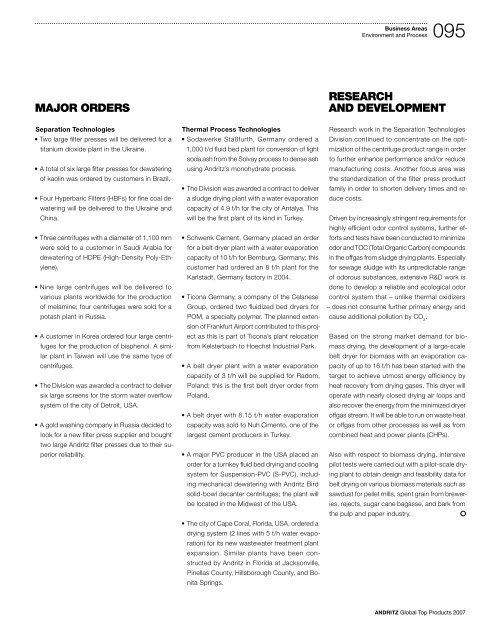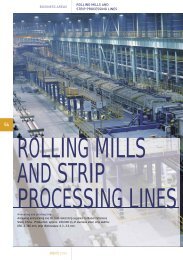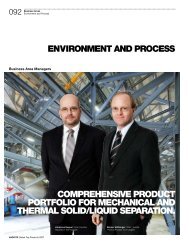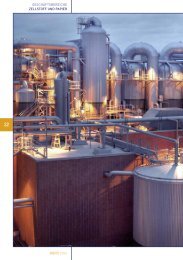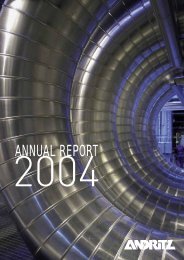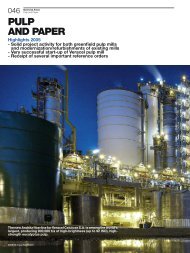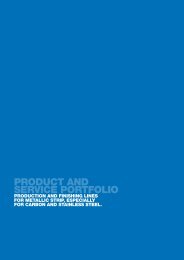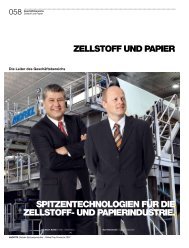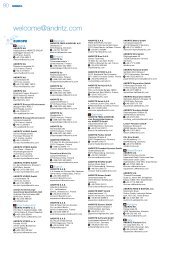Andritz Annual Report 2007 - andritz business areas
Andritz Annual Report 2007 - andritz business areas
Andritz Annual Report 2007 - andritz business areas
You also want an ePaper? Increase the reach of your titles
YUMPU automatically turns print PDFs into web optimized ePapers that Google loves.
Business Areas<br />
Environment and Process<br />
095<br />
Major orders<br />
Research<br />
and Development<br />
Separation Technologies<br />
• Two large filter presses will be delivered for a<br />
titanium dioxide plant in the Ukraine.<br />
• A total of six large filter presses for dewatering<br />
of kaolin was ordered by customers in Brazil.<br />
• Four Hyperbaric Filters (HBFs) for fine coal dewatering<br />
will be delivered to the Ukraine and<br />
China.<br />
• Three centrifuges with a diameter of 1,100 mm<br />
were sold to a customer in Saudi Arabia for<br />
dewatering of HDPE (High-Density Poly-Ethylene).<br />
• Nine large centrifuges will be delivered to<br />
various plants worldwide for the production<br />
of melamine; four centrifuges were sold for a<br />
potash plant in Russia.<br />
• A customer in Korea ordered four large centrifuges<br />
for the production of bisphenol. A similar<br />
plant in Taiwan will use the same type of<br />
centrifuges.<br />
• The Division was awarded a contract to deliver<br />
six large screens for the storm water overflow<br />
system of the city of Detroit, USA.<br />
• A gold washing company in Russia decided to<br />
look for a new filter press supplier and bought<br />
two large <strong>Andritz</strong> filter presses due to their superior<br />
reliability.<br />
Thermal Process Technologies<br />
• Sodawerke Staßfurth, Germany ordered a<br />
1,000 t/d fluid bed plant for conversion of light<br />
soda ash from the Solvay process to dense ash<br />
using <strong>Andritz</strong>’s monohydrate process.<br />
• The Division was awarded a contract to deliver<br />
a sludge drying plant with a water evaporation<br />
capacity of 4.9 t/h for the city of Antalya. This<br />
will be the first plant of its kind in Turkey.<br />
• Schwenk Cement, Germany placed an order<br />
for a belt dryer plant with a water evaporation<br />
capacity of 10 t/h for Bernburg, Germany; this<br />
customer had ordered an 8 t/h plant for the<br />
Karlstadt, Germany factory in 2004.<br />
• Ticona Germany, a company of the Celanese<br />
Group, ordered two fluidized bed dryers for<br />
POM, a specialty polymer. The planned extension<br />
of Frankfurt Airport contributed to this project<br />
as this is part of Ticona’s plant relocation<br />
from Kelsterbach to Hoechst Industrial Park.<br />
• A belt dryer plant with a water evaporation<br />
capacity of 3 t/h will be supplied for Radom,<br />
Poland; this is the first belt dryer order from<br />
Poland.<br />
• A belt dryer with 8.15 t/h water evaporation<br />
capacity was sold to Nuh Cimento, one of the<br />
largest cement producers in Turkey.<br />
• A major PVC producer in the USA placed an<br />
order for a turnkey fluid bed drying and cooling<br />
system for Suspension-PVC (S-PVC), including<br />
mechanical dewatering with <strong>Andritz</strong> Bird<br />
solid-bowl decanter centrifuges; the plant will<br />
be located in the Midwest of the USA.<br />
• The city of Cape Coral, Florida, USA, ordered a<br />
drying system (2 lines with 5 t/h water evaporation)<br />
for its new wastewater treatment plant<br />
expansion. Similar plants have been constructed<br />
by <strong>Andritz</strong> in Florida at Jacksonville,<br />
Pinellas County, Hillsborough County, and Bonita<br />
Springs.<br />
Research work in the Separation Technologies<br />
Division continued to concentrate on the optimization<br />
of the centrifuge product range in order<br />
to further enhance performance and/or reduce<br />
manufacturing costs. Another focus area was<br />
the standardization of the filter press product<br />
family in order to shorten delivery times and reduce<br />
costs.<br />
Driven by increasingly stringent requirements for<br />
highly efficient odor control systems, further efforts<br />
and tests have been conducted to minimize<br />
odor and TOC (Total Organic Carbon) compounds<br />
in the offgas from sludge drying plants. Especially<br />
for sewage sludge with its unpredictable range<br />
of odorous substances, extensive R&D work is<br />
done to develop a reliable and ecological odor<br />
control system that – unlike thermal oxidizers<br />
– does not consume further primary energy and<br />
cause additional pollution by CO 2<br />
.<br />
Based on the strong market demand for biomass<br />
drying, the development of a large-scale<br />
belt dryer for biomass with an evaporation capacity<br />
of up to 16 t/h has been started with the<br />
target to achieve utmost energy efficiency by<br />
heat recovery from drying gases. This dryer will<br />
operate with nearly closed drying air loops and<br />
also recover the energy from the minimized dryer<br />
offgas stream. It will be able to run on waste heat<br />
or offgas from other processes as well as from<br />
combined heat and power plants (CHPs).<br />
Also with respect to biomass drying, intensive<br />
pilot tests were carried out with a pilot-scale drying<br />
plant to obtain design and feasibility data for<br />
belt drying on various biomass materials such as<br />
sawdust for pellet mills, spent grain from breweries,<br />
rejects, sugar cane bagasse, and bark from<br />
the pulp and paper industry.<br />
ANDRITZ Global Top Products <strong>2007</strong>


